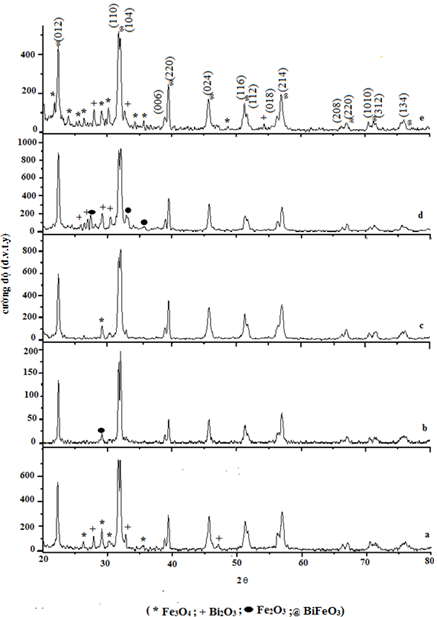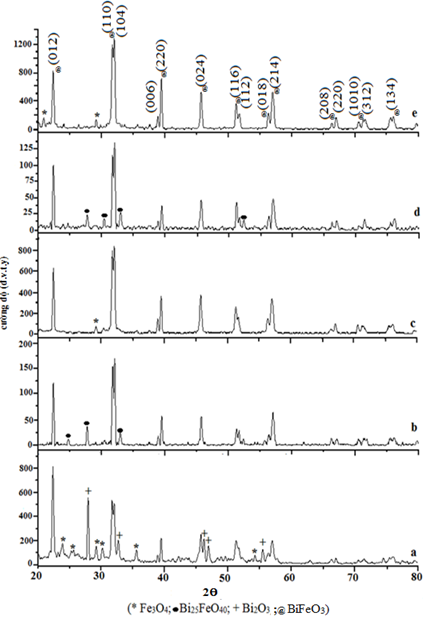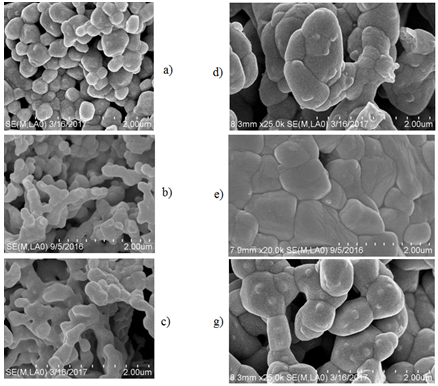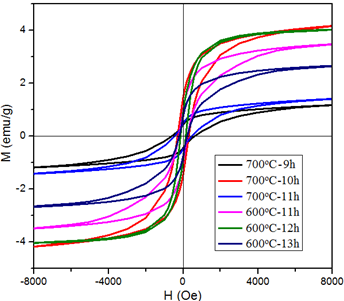ВЛИЯНИЕ РЕЖИМОВ КАЛЬЦИНАЦИИ НА ФАЗОФОРМИРОВАНИЕ И МАГНИТНЫЕ СВОЙСТВА НАНОЧАСТИЦ BiFeO3, СИНТЕЗИРОВАННЫХ ЗОЛЬ-ГЕЛЬ МЕТОДОМ С ИСПОЛЬЗОВАНИЕМ ЛИМОННОЙ КИСЛОТЫ
Пхам Маи Ан1, Нгуйен Ван Чуонг2, Ву Тхи Туйет3
1ORCID: Кандидат физико-математических наук, Университет Тхайнгуена, Провинция Тхайнгуен, Вьетнам, 2ORCID: Магистрант, Научный институт Тхайнгуена, Провинция Тхайнгуен, Вьетнам, 3ORCID: Магистр физики, Университет Тхайнгуена, Провинция Тхайнгуен, Вьетнам
ВЛИЯНИЕ РЕЖИМОВ КАЛЬЦИНАЦИИ НА ФАЗОФОРМИРОВАНИЕ И МАГНИТНЫЕ СВОЙСТВА НАНОЧАСТИЦ BiFeO3, СИНТЕЗИРОВАННЫХ ЗОЛЬ-ГЕЛЬ МЕТОДОМ С ИСПОЛЬЗОВАНИЕМ ЛИМОННОЙ КИСЛОТЫ
Аннотация
Наноразмерные мультиферроические порошки BiFeO3 (BFO) синтезировали золь-гель методом с использованием лимонной кислоты в качестве хелатирующего агента. Образцы кальцинировали при разных температурах и в разные периоды времени. Фазовый анализ образцов проводили с помощью рентгеновской дифрактометрии (РД). Морфологию частиц порошка BiFeO3 исследовали с помощью сканирующего электронного микроскопа (СЭМ). Измерения магнитного гистерезиса при комнатной температуре (M-H) проводили с использованием вибрационного магнитометра. Результаты показывают, что фазовый состав BFO порошков, кальцинированных при 600 ºC в течение 11-12 часов и при 700 ºC в течение 10 часов, был самым высоким. Морфология образца порошка, нагретого при 600 ºC в течение 12 часов, была лучше, магнитные характеристики образцов, нагретых при 600 ºC в течение 12 часов и при 700 ºC в течение 10 часов, были лучше, чем у остальных.
Ключевые слова: фотокатализаторы, порошки BFO, морфология, кривые M-H.
Pham Mai An1, Nguyen Van Chuong2, Vu Thi Tuyet3
1ORCID: PhD in Physico-Mathematical Sciences, Thai Nguyen University of Education, Thai Nguyen province, Vietnam, 2ORCID: Graduate Student, Thai Nguyen University of Sciences, Thai Nguyen province, Vietnam, 3ORCID: Master of Science in Physics, Thai Nguyen University of Education, Thai Nguyen province, Vietnam
INFLUENCE OF CALCINATION REGIMES ON PHASE FORMATION AND MAGNETIC PROPERTY OF NANOPOWDERS BiFeO3 SYNTHESIZED BY SOL-GEL METHOD USING CITRIC ACID
Abstract
Nano-sized multiferroic BiFeO3 (BFO) powders were synthesized by sol-gel method using citric acid as a chelating agent. Samples were calcinated at different temperatures and in different time periods. The phase analysis of the samples was carried out by X-ray diffractometry (XRD). A morphology of BiFeO3 powder particles was investigated with scanning electron microscope (SEM). Room temperature magnetic hysteresis (M-H) measurements were carried out using a vibrating sample magnetometer. The results show that BFO phase composition of powders calcinated at 600 ºC for 11 to 12 hours and at 700 ºC for 10 hours was highest, powder morphology of the sample heated at 600 ºC for 12 hours was the best, magnetic characteristics of samples heated at 600 ºC for 12 hours and at 700 ºC for 10 hours were better than the rest.
Keywords: photocatalysts, BFO powders, morphology, M-H curves.
Introduction
Multiferroic BiFeO3 has been attracted considerable interest due to its potential applications in in data storage, spintronics, sensors and microelectronic devices, etc. [3], [7]. It is one of the rare multiferroic materials which exhibits ferroelectricity (TC ~ 1100 K) and antiferromagnetism (TN ~ 640 K) simultaneously above room temperature [1], [4]. BiFeO3 nanoparticles also show good photocatalytic activities in visible-light region due to narrow band gap (2.1-2.7eV) [2], which can be used as novel visible-light responsive photocatalysts for degradation of organic pollutants or for H2 generation from water.
BFO powders are being prepared by other methods such as the solid state methods, mechano-chemical method, solution Chemistry methods, hydro thermal methods, sonochemical and sol-gel methods [2], [3], [6]. Further, it is very difficult to obtain a pure single-phase product because of the very narrow range of the synthesis temperature and calcination time for phase stability [1], [5]. Sol-gel process with various hydrolysis catalysts has been proven for several years, which is now efficient for the processing of BiFeO3 as powder and thin film materials [2], [3], [4]. In this work, sol-gel method with citric acid was used for the synthesis of BFO powder samples. Samples were sintered at various temperatures for different time periods and their phase composition, morphology and magnetic properties are studied.
Experimental
In this investigation, BFO powders were prepared by sol-gel method. bismuth nitrate Bi(NO3)3.5H2O (purity ≥ 99%), iron nitrate Fe(NO3)3.9H2O (purity ≥ 98,5%) were used as precursors. Citric acid monohydrate C6H8O7.H2O (purity ≥ 99,5%) and ammonia solution NH4OH were used as hydrolysis catalysts. Firstly, Bi(NO3)3.5H2O and Fe(NO3)3.9H2O in stoichiometric proportions (1/1 molar ratio) were stirred in distilled water for 30 minutes, and then citric acid was added cautiously into the solution under stirring condition. The ammonia solution was added drop-wise into the mixed solution to keep pH level between 8 and 10. The solution was stirred continuously at room temperature for 15 hours. Then, temperature of the solution was increased to 90 ºC and maintained until wet-gel was obtained. In the next step, wet-gel was dried at 120 ºC to obtain dry gel. Finally, this dry gel was calcinated in Lenton furnace at 600 °C (± 10 °C) for 10 h, 11 h, 12 h, 13 h, 14h and at 700 °C (± 10 °C) for 8 h, 9 h, 10 h, 11 h, 12 h.
The crystal structure and phase composition of BFO powders were examined using X-ray diffraction (XRD) (D8 Advance – Bruker with Cu-Kα radiation). A morphology of BFO powder particles was investigated with scanning electron microscope (SEM) S4800 – NIHE. Room temperature magnetic hysteresis (M-H) measurements were carried out using a vibrating sample magnetometer (model EV11-VSM, KLA Tencor - USA).
Results and discussion
XRD patterns of BFO powders calcinated at 600 ºC for 10 h, 11 h, 12 h, 13 h, 14h and at 700 ºC for 8 h, 9 h, 10 h, 11 h, 12 h were shown in figure 1 and figure 2. The prominent peaks in XRD plots are indexed to various (hkl) planes of BFO. The X-ray diffraction pattern for all samples shows that BFO exhibits rhombohedrally distorted perovskite structure with space group R3c. The lattice parameters were calculated as a = b = 5.5876 Å, c=13.867 Å. Besides, secondary phases as Fe3O4, Bi2O3, Fe2O3, Bi25FeO40 in XRD plots also were reported. The results showed that with increase of calcination temperature (in the same period of time) or time period (at 600 ºC and 700 ºC), the peaks related to BiFeO3 phase become stronger while that of secondary phases weaken . However, calcination temperature and length of time would be above a limit, the secondary phases increased. It can be due to overcoming thermal stability of BiFeO3 phase. BFO phase composition of powders calcinated at 600 ºC for 11 or 12 hours and at 700 ºC for 10 hours were highest.

Fig. 1 – XRD patterns of BFO powders calcinated at 600 ºC for: a) 10h; b) 11h; c) 12h; d) 13h; e) 14h

Fig. 2 – XRD patterns of BFO powders calcinated at 700 ºC for: a) 8h; b) 9h; c) 10h; d) 11h; e) 12h
The scanning electron microscope (SEM) images of BFO powders were shown in figure 3. The SEM images show that morphology of BiFeO3 powders changes not much with different heating time periods at same sintering temperature. The morphology of BiFeO3 powders fired at various sintering temperature is significantly different. BiFeO3 particles of sample sintered at 600 ºC (Fig…) are homogeneous with the size of 200 – 250 nm while the particles of sample heated at 700 ºC (Fig…) coalesce into larger clusters and they are not homogeneous.

Fig. 3 – SEM images of BFO powders calcinated at 600 ºC for 11h (a) 12h (b), 13h (c) and at 700 ºC for 9h (d), 10h (e), 11h (g)

Fig. 4 – M-H curves of BFO samples calcinated at various temperatures
Table 1 – Basic magnetic parameters of samples
| Time - Temperature | Mr (emu/g) | Ms(emu/g) | Hc (Oe) |
| 11h-600oC | 1,12 | 3,5 | 236 |
| 12h-600oC | 1,14 | 4,0 | 144 |
| 13h-600oC | 0,75 | 2,78 | 213 |
| 9h-700oC | 0,46 | 1,21 | 614 |
| 10h-700oC | 1,31 | 4,1 | 298 |
| 11h-700oC | 0,48 | 1,4 | 451 |
Figure 4 shows the room temperature magnetization hysteresis loops of BFO samples calcinated at various temperatures and in different time periods. M-H curves exhibit magnetic hysteresis for all the samples. The results showed that the samples exhibited weak ferromagnetic order. Among these, two samples heated at 600 ºC for 12 hours and at 700 ºC for 10 hours had better magnetic characteristics than the rest. Basic magnetic parameters of samples are shown in table 1.
Conclusions
In summary, BiFeO3 nanopowders were successfully synthesized by sol-gel method using citric acid. The phase composition and crystal structure analysis of the samples was carried out by X-ray diffractometry (XRD). A morphology of BiFeO3 powder particles was investigated with scanning electron microscope (SEM). Room temperature magnetization hysteresis loops (M-H curves) obtained by vibrating sample magnetometer. The results confirmed that phase quality of samples calcinated at 600 ºC for 11 to 12 hours and at 700 ºC for 10 hours was highest, powder morphology of the sample heated at 600 ºC for 12 hours was the best, magnetic characteristics of samples heated at 600 ºC for 12 hours and at 700 ºC for 10 hours were better than the rest.
Список литературы / References
- Fischer P. Temperature dependence of the crystal and magnetic structures of BiFeO3 / P. Fischer, M. Polomskya, I. Sosnowska, M. Szymanksi // J. Phys. C: Solid State Phys. – 1980. – 13. – P. 1931–1940.
- Gao T. A review: preparation of bismuth ferrite nanoparticles and its applications in visible-light induced photocatalyses / T. Gao, Z. Chen, Q. Huang, F. Niu, X. Huang, L. Qin and Y. Huang // Rev.Adv.Mater.Sci. – 2015. – 40. – P. 97-109.
- Gustau Catalan. Physics and Applications of Bismuth Ferrite”/ Gustau Catalan, James F. Scott // Adv. Mater. – 2009. – 21. – P. 2463–2485.
- Lee S.W. Growth of multiferroics BiFeO3 thin films by sol–gel method / S.W. Lee, C.S. Kim // Journal of Magnetism and Magnetic Materials. – 2006. – 304. – P. e772–e774
- Lu. J. Phase equilibrium of Bi2O3–Fe2O3 pseudobinary system and growth of BiFeO3 single crystal / J. Lu, L.J. Qiao, P.Z. Fu, Y.C. Wu // J. Cryst. Growth. – 2011. – 318. – P. 936–941.
- Manisha Arora. Structural, Optical and Multiferroic Properties of BiFeO3 Nanoparticles Synthesized Soft Chemical Route / Manisha Arora, P.C. Sati, Sunil Chauhan, Sandeep Chhoker, A.K. Panwar & Manoj Kumar // J. Supercond Nov Magn. – 2012. – Vol. 25, No. 4. – DOI 10.1007/s10948-012-1761-4
- Wang K.F. Multiferroicity: the coupling between magnetic and polarization orders / K.F. Wang, J.M. Liu, Z.F. Ren // Adv. Phys. – 2009. – 58. – P. 321-448.
